ParkCAD 4.0 is the latest version of Transoft Solution's CAD parking site design software. It includes new features that make designing parking lots a much more refined process, with support of arcs in the creation of perimeter rows and drive aisles.
February 6, 2012
Read time: 1 min
ParkCAD 4.0 is the latest version of 2187 Transoft Solution's CAD parking site design software. It includes new features that make designing parking lots a much more refined process, with support of arcs in the creation of perimeter rows and drive aisles. The software now lets users run different combinations of row positions and rotations, yielding the maximum number of parking spaces in a boundary. The new design manager functionality also allows multiple iterations of parking layouts to be saved, updated, recalled and then compared for client proposals and parking studies.










